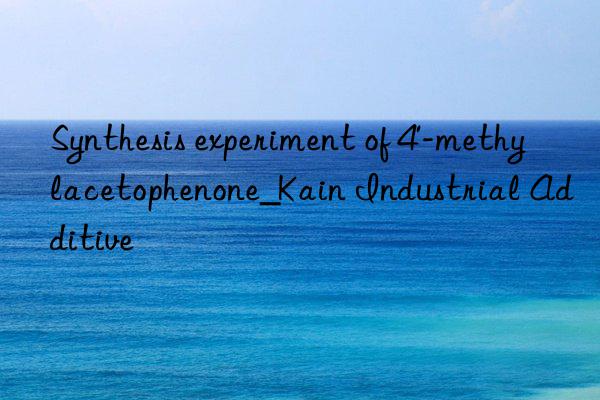
4-Methyl acetophenone has a scent similar to hawthorn flowers, alfalfa, and strawberry. It can be used to prepare lilac-type flavors and fruit food flavors, and is an important chemical intermediate. The "4-methylacetophenone synthesis" experiment is one of the widely used classic organic chemistry teaching experiments.
1. Experimental steps
(1) Prepare the methanol solution of the synthetic product of 4-methylacetophenone and the standard sample (purchased from Aldrich, purity 95%): Use a 10μL syringe to transfer 5.0μL of the synthetic product of 4-methylacetophenone, and add Pour into a 10 mL Erlenmeyer flask containing 1.00 mL HPLC grade methanol, mix evenly and set aside.
(2) After the GC-MS coupling instrument is stable, use a 5.0 μL injector to take 1.0 μL of the synthetic product of 4-methylacetophenone and the methanol solution of the standard sample for analysis, and use the GC temperature programmed method. Optimized analysis conditions: 70°C as the initial temperature, rising to 170°C at 25°C/min, and holding for 1 min.
To facilitate comparison, the chromatograms and mass spectra were normalized by dividing the original chromatogram and mass spectrum abundance signals by the strongest peak abundance signal.
2. Results and discussion
2.1 Establishment of fast and efficient chromatographic analysis conditions
First, we established the chromatographic analysis conditions based on the chromatographic theory and the characteristics of the samples to be analyzed. We tried to set the initial temperature to 70, 80, 90, and 100°C, and then raised the temperature to 170°C at a heating rate of 10, 15, 20, and 25°C/min. Various programmed temperature-increasing chromatographic conditions such as holding for 1 min were used to optimize the appropriate chromatographic conditions, that is, various programmed temperature-increasing chromatographic conditions were programmed to increase the temperature from 70°C to 170°C at a heating rate of 25°C/min and maintained for 1 min. Suitable chromatographic conditions were optimized. The chromatographic conditions are programmed heating from 70°C to 170°C at a heating rate of 25°C/min and maintained for 1 min. The chromatogram of the obtained 4-methylacetophenone synthesis product is shown in Figure 1a. It can be clearly seen that the The analysis time is only about 4.5 minutes, which meets our requirements for fast and efficient separation and analysis, and can effectively solve the contradiction between the large number of students and the small number of instruments in experimental teaching practice.
2.2 Chromatogram and mass spectrum analysis
Figure 1 shows the chromatograms of 4-methylacetophenone synthesis products and standard samples and the mass spectra corresponding to each chromatographic peak. It can be clearly seen from Figure 1a that the components in the 4-methylacetophenone synthesis product are completely separated. The content of each component calculated by the peak area normalization method is 4.94%, 7.42%, 87.03%, 0.61%. First, mass spectrometry was used to qualitatively assign these chromatographic peaks. The first three peaks came from three methylacetophenones (2-, 3-, and 4-methylacetophenone), and the chromatographic peak with a retention time of 4.391 min was assigned to 2, 4-Dimethylacetophenone. It is worth noting that because the mass spectra of the first three chromatographic peaks are highly similar (see Figure 1c~1e), they cannot be assigned accurately. Obviously, the quadrupole mass spectrometer has encountered difficulties here. Accordingly, students are guided to explore the following issues based on the above experimental results and combined with the theoretical knowledge they have learned.
According to the principle of chromatography, the standard sample method is a good qualitative method that can identify and attribute chromatographic peaks. The disadvantage is that a corresponding standard sample is required, but not every compound's standard sample can be obtained. As far as the "synthesis of 4-methylacetophenone" experiment is concerned, our laboratory only has the 4-methylacetophenone standard sample purchased from Aldrich. Its chromatogram is shown in Figure 1b. There are two chromatograms located at 3.929 and 3.929 respectively. The chromatographic peak at 4.015min, of which the area percentage of the 4.015min chromatographic peak is 97.5%, thus it can be determined that the chromatographic peak near 4.015min comes from 4-methylacetophenone. On the basis of completing the analysis of standard samples, it is still necessary to use the differences in the physical property parameters of each substance to infer the order of chromatographic peaks on a specific chromatographic column. Generally speaking, the peak order of each substance is determined by the boiling point and polarity of the substance, the polarity of the chromatographic column, etc. On the weakly polar HP-5MS chromatographic column, substances with high boiling points and strong polarity flow out of the column last. . We noticed that the boiling points of 2-, 3-, and 4-methylacetophenone are 214, 218~220, and 226°C respectively [13, 14, 15], and their molecular polarity also increases in sequence. Therefore, the first three chromatographic peaks in Figure 1a can be assigned to 2-, 3-, and 4-methylacetophenone in sequence.
3. Conclusion
Combined with GC-MS technology, we have established an effective experimental method for rapid analysis and identification of 4-methylacetophenone synthesis products, and explored a new research-based teaching method to improve students' comprehensive abilities. Judging from the teaching practice, good teaching effects have been achieved, and students' knowledge level and ability to ask and solve problems have been improved.
References
[1]Wu Meifang, Li Lin. Organic chemistry experiments[M]. Beijing: Science Press, 2013.
[2]Da Shilu. Introduction to Chromatography[M]. Wuhan: Wuhan University Press, 1999.
[3]He Hua, Ni Kunyi. Modern chromatographic analysis[M]. Beijing: Chemical Industry Press, 2004:80-179.
[4]Wang Zhengfan. Qualitative and quantitative chromatography[M]. Chemical Industry Press, 2007:11-122.
[5]Fang Huiqun, Yu Junsheng, Shi Jian. Instrumental Analysis[M]. Beijing: Science Press, 2008:77-392.
[6] Yang Zhenghua, Zhang Guiqin, Ding Mengxian. Preparation of a new chiral stationary phase for gas chromatography and its resolution of crystallized racemates [J]. Analytical Chemistry, 1996, 24:869-872.
[7] Li Lin (translator), Wang Muzou (principal). Chromatographic separation of chiral isomers [J]. Foreign Medicine (Pharmaceutical Volume), 1987 (5): 303-305.
[8] Wang Jiangke, Zhong Yueming, Luo Honghong, et al. Gas chromatographic analysis of amino acid enantiomers in fossils [J]. Experimental Technology and Management, 1987 (4): 19-21.
[9] Benjamin J. Jarzinowitz, Michael J. Jarzinowitz, Horace F. Martin. Gas Chromatograph-Mass SpectrometryApplication analysis system[M]. Beijing: Machinery Industry Press, 1982:58-576.



 微信扫一扫打赏
微信扫一扫打赏
